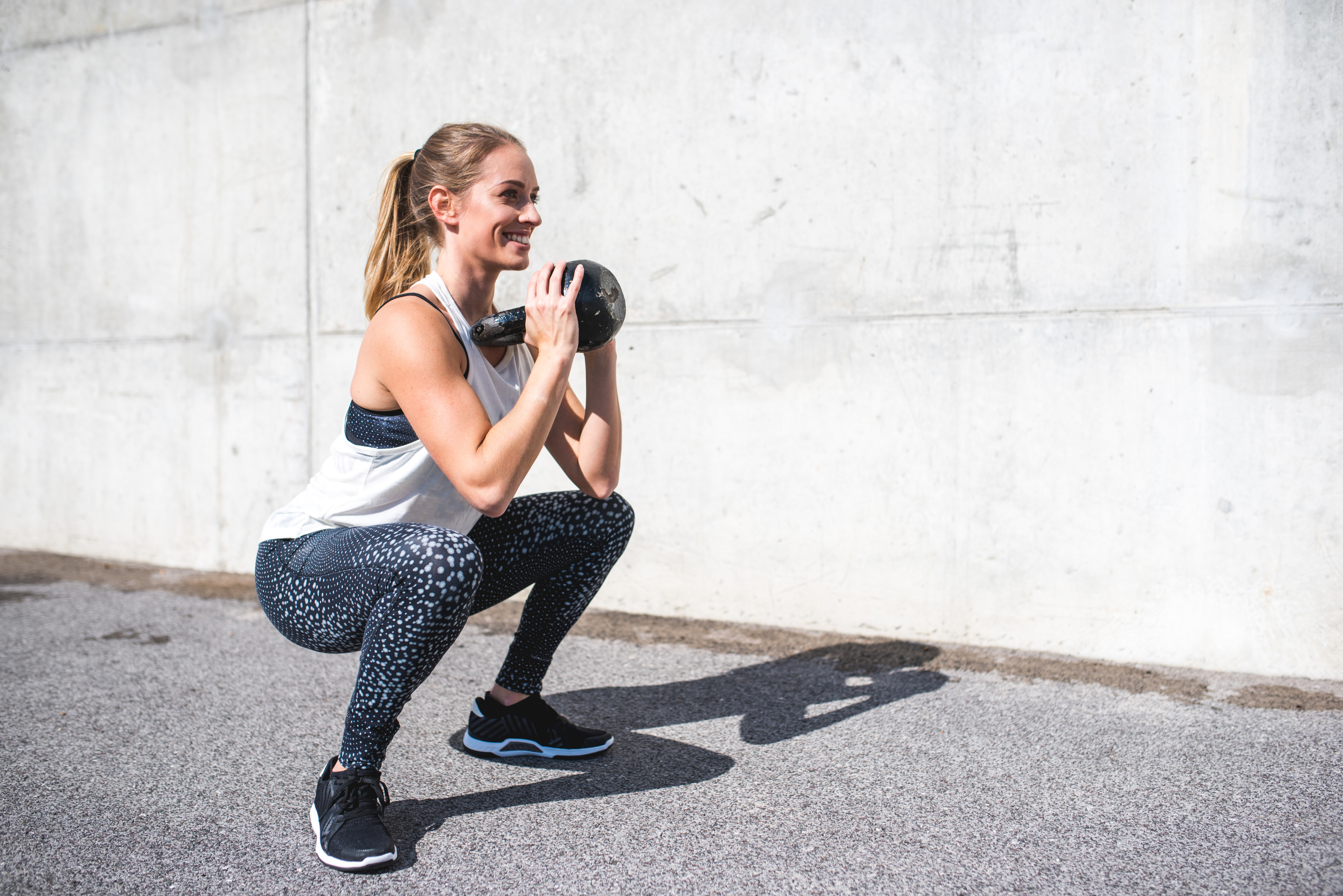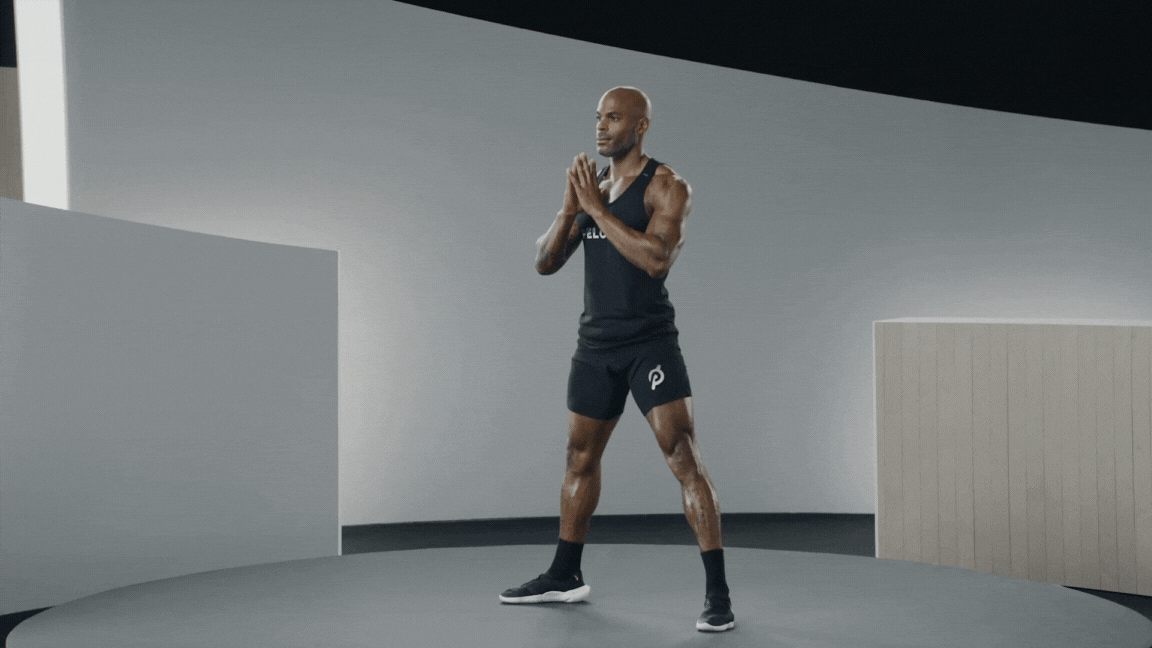
kovaciclea/E+ via Getty Images
This Squat Variation Builds Lower Body Strength—and Improves Your Hip Mobility
Learn how to do the sumo squat and why it deserves a spot in your leg workouts.
By Emily Laurence•
What Is a Sumo Squat?
What Muscles Do Sumo Squats Work?
Sumo Squat Benefits
How to Correctly Do a Sumo Squat
Sumo Squats: Variations and Modifications
Mistakes to Avoid When Doing Sumo Squats
How to Incorporate Sumo Squats Into Your Workout Routine
There’s a reason why squats are a favorite workout move for fitness instructors: They work all the major muscles in the lower body. Though they're effective, sometimes it’s good to vary the type of squat you do. Similar to how you get slightly different benefits from different types of cardio, the same goes for when you switch up your squats game.
One squat variation worth working into your routine is the sumo squat. The sumo squat challenges lower body muscles in a different way than other types of squats and focuses more on the inner thigh muscles. Just like with other workout moves, in order to reap the full benefits—and avoid injury—it’s important to know how to do a sumo squat correctly.
What Is a Sumo Squat?
“A sumo squat is a squat variation that is performed in a wide stance, externally rotated,” says Peloton instructor Rebecca Kennedy. Similar to standard squats, sumo squats are a compound movement, which means that it works multiple muscle groups at the same time. In this case, Rebecca says that the muscles worked during a sumo squat include the quadriceps, hamstrings, calves, glutes, adductors (the inner thighs), core, and pelvic floor. That’s a lot of benefits for just one move!
How Do Sumo Squats Differ From Other Squats?
Rebecca explains that the main difference between a sumo squat and other types of squats is the stance, which requires open hips and externally rotated legs and feet; it’s a wider stance than a standard squat calls for.
Another difference between a sumo squat and other types of squats is that the sumo squat targets the adductors (aka the inner thigh muscles) more. “The sumo squat uses all the muscles as a traditional squat but it also strengthens adductors and the pelvic floor,” she says. She adds that the sumo squat puts less pressure on the lower back than other types of squats. “The wider base often makes this an easier squat as the ankle mobility isn't stressed as much as a traditional squat,” she says.
What Muscles Do Sumo Squats Work?
It bears repeating that if you want to target your entire lower body with one move, the sumo squat is a great one to prioritize. All of the muscles sumo squats engages are listed below:
Glutes: The maximus, minimus, medius gluteus are all engaged when doing a sumo squat, Rebecca says. The gluteus maximus are the body’s largest muscle and form the shape of the butt and hips. The gluteus medius and gluteus minimus are important for hip stability and movement.
Quadriceps: The quadriceps are a group of muscles located on the front of the thigh. They’re important for common everyday movements, including walking, running, and jumping.
Hamstrings: The hamstrings consist of three muscles that run from the thigh to the knee and are used to help bend the knee.
Adductors: The adductors are inner thigh muscles that provide pelvis and hip stability.
Calves: The calf muscles are found at the back of the lower leg, starting below the knee and extending to the ankle. Calf muscles are important for standing, walking, running, jumping…basically anything that involves your legs.
Core: The core muscles are important for stabilizing the body, boosting athletic performance, increasing everyday agility, and preventing injury.
Pelvic floor: The pelvic floor is a group of muscles that runs from the tailbone to the pubic bone and helps with bladder and bowel control, supporting the spine and hips, and helps with breathing and blood circulation to this region of the body.
Sumo Squat Benefits
Knowing what muscles sumo squats engage is helpful, but what you likely really want to know is what you actually gain from doing them. Rebecca says that there are three key benefits of doing sumo squats: They help with overall leg strength, balance, and mobility.
Any exercise that targets the quads, hamstrings, glutes, and adductors contributes to building leg strength. Rest assured, if you do sumo squats regularly, your legs will get stronger. Curious as to how sumo squats help with balance? As Rebecca previously pointed out, one muscle group that sumo squats target is the core. Core-strengthening exercises, like the sumo squat, help improve posture and balance because a strong core leads to more steadiness, making both balance and proper easier.
How Sumo Squats May Improve Your Hip Mobility
As Rebecca stated, another benefit of sumo squats is that they can help with mobility—hip mobility in particular. “A sumo squat can help improve hip mobility because the wider stance increases the range of motion at the hip joint while the muscles surrounding the joints are stretched, improving flexibility as well,” she explained.
Remember how Rebecca called out the adductors as one of the muscle groups engaged while during sumo squats? The adductors are key for hip stability, which is why this workout move is so great for keeping your hips agile.
How to Correctly Do a Sumo Squat
Convinced that you can benefit from doing sumo squats? Rebecca shares how to do them step by step below:

1. Take a Wide Stance. Start by standing with your hips slightly wider than hip-distance apart and turn your feet outwards.
2. Lower Your Body Down. Lower down into a squat. Bend your knees until they are bent at 90 degrees. Maintain a neutral spine with your chest lifted. Keep your feet flat on the floor.
3. Stand Up. While maintaining a neutral spine and keeping your feet flat on the floor, come back up to the starting position. Complete between eight and 12 reps.
Sumo Squats: Variations and Modifications
While you do want to feel your muscles working, nothing should hurt when you do a sumo squat. If doing a sumo squat is inaccessible to you right now, Rebecca says it can easily be modified. To do so, she recommends reducing the width of the stance by bringing your feet slightly closer together. This reduces the range of the squat; you’re still getting the benefits, but you aren’t going as deep.
Want to make it harder? Rebecca says you can do so by increasing your depth or range of motion. You can do this by standing on a raised platform, two plates, or boxes. Take it to the next level by holding a weight goblet-style, which increases demand on the core and legs.
Mistakes to Avoid When Doing Sumo Squats
One mistake that is important to avoid when doing sumo squats is not maintaining a neutral spine. “Avoid arching or rounding your spine,” she says. This is important because keeping the spine neutral protects it from experiencing excessive compression.
Rebecca also says that another mistake is not keeping feet flat on the floor when doing a sumo squat. Keeping your feet flat gives more stability for the hips, knees, and ankles.
How to Incorporate Sumo Squats Into Your Workout Routine
Now that you know how to properly do a sumo squat and what the benefits are, you may be wondering how you can incorporate it into your workout routine. The beauty of this no-equipment move is that it can be done any time, any place. You can do sumo squats in the morning, in the middle of the day, or in the evening in front of the TV. They can also be done before or after you work out, as part of a stretching routine.
To experience the maximum benefit, aim to do two to three sets of sumo squats two to three times a week.
Standard squats are still a great way to work your lower legs. But if you want to target slightly different muscles—especially your inner thighs—sumo squats is a great way to switch things up.

Peloton App
Access thousands of classes with no equipment needed.
This content is for informational and educational purposes only and does not constitute individualized advice. It is not intended to replace professional medical evaluation, diagnosis, or treatment. Seek the advice of your physician for questions you may have regarding your health or a medical condition. If you are having a medical emergency, call your physician or 911 immediately.
Level up your inbox.
Subscribe for a weekly dose of fitness, plus the latest promos, launches, and events.
By providing your email address, you agree to receive marketing communications from Peloton.
For more about how we use your information, see our Privacy Policy.






